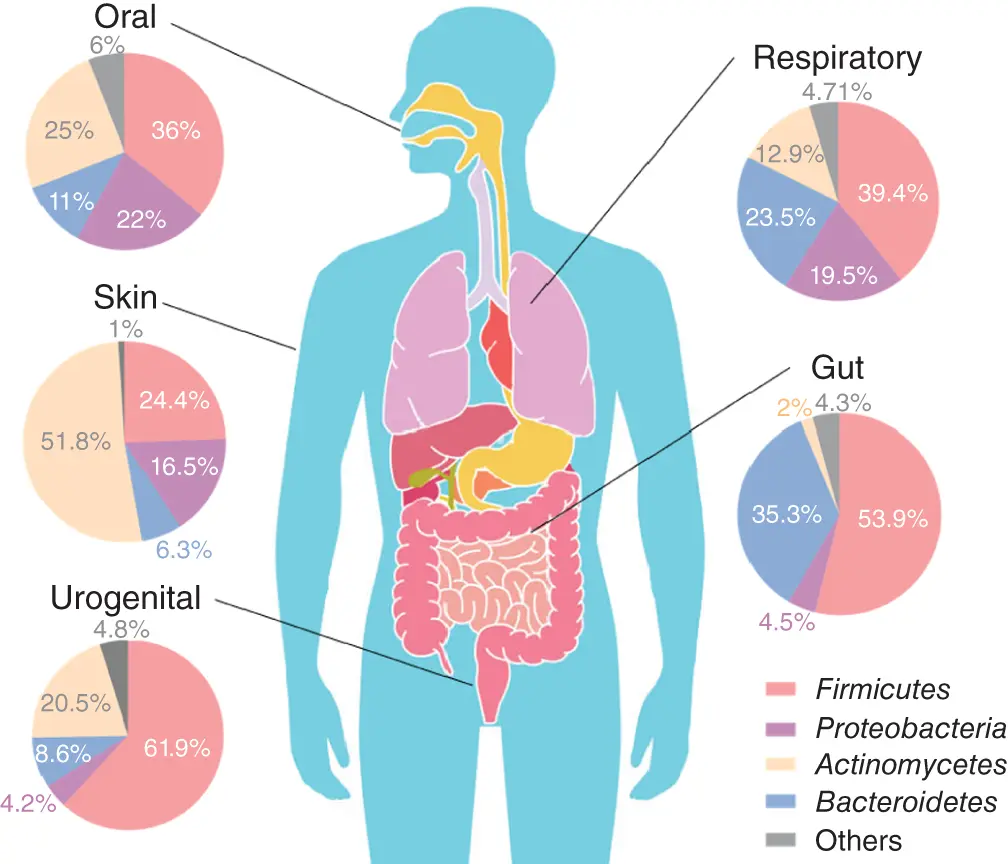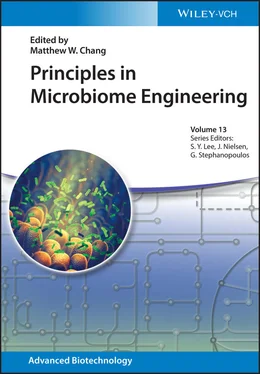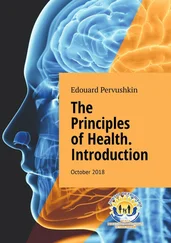Principles in Microbiome Engineering
Здесь есть возможность читать онлайн «Principles in Microbiome Engineering» — ознакомительный отрывок электронной книги совершенно бесплатно, а после прочтения отрывка купить полную версию. В некоторых случаях можно слушать аудио, скачать через торрент в формате fb2 и присутствует краткое содержание. Жанр: unrecognised, на английском языке. Описание произведения, (предисловие) а так же отзывы посетителей доступны на портале библиотеки ЛибКат.
- Название:Principles in Microbiome Engineering
- Автор:
- Жанр:
- Год:неизвестен
- ISBN:нет данных
- Рейтинг книги:5 / 5. Голосов: 1
-
Избранное:Добавить в избранное
- Отзывы:
-
Ваша оценка:
- 100
- 1
- 2
- 3
- 4
- 5
Principles in Microbiome Engineering: краткое содержание, описание и аннотация
Предлагаем к чтению аннотацию, описание, краткое содержание или предисловие (зависит от того, что написал сам автор книги «Principles in Microbiome Engineering»). Если вы не нашли необходимую информацию о книге — напишите в комментариях, мы постараемся отыскать её.
Provides an overview of the techniques and applications insight into the complex composition and interactions of microbiomes Principles in Microbiome Engineering
Principles in Microbiome Engineering
Principles in Microbiome Engineering — читать онлайн ознакомительный отрывок
Ниже представлен текст книги, разбитый по страницам. Система сохранения места последней прочитанной страницы, позволяет с удобством читать онлайн бесплатно книгу «Principles in Microbiome Engineering», без необходимости каждый раз заново искать на чём Вы остановились. Поставьте закладку, и сможете в любой момент перейти на страницу, на которой закончили чтение.
Интервал:
Закладка:
Department of Biomedical Engineering, Southern University of Science and Technology (SUSTech), Shenzehn 518055, China
1.1 Introduction
The microbiota refers to the total population of microbes that co‐exist with the host, whereas the microbiome is the regulated genomic composition of the microbiota. The microbiome was initially coined to study the co‐existing relationship between microbes and the hosting environment by Mohr in 1952 but only gained attention and recognition in the genomic era during the early 2000s [1, 2]. Microorganisms are present everywhere in our daily lives, establishing transient or permanent interactions with the human host. It is estimated that around 10–100 trillion microbes are present in the human body [3]. Although many different types of microbes co‐exist in human bodies such as viruses, fungi, and protozoa, bacteria are the most well studied and represented for their largest proportion and intimate relation with human health. The microbiota is shaped by the host's biochemistry, nutrition intake, and lifestyle pattern. In kind the microbiome influences human health through nutritional processes, immunomodulatory functions, manipulating the host behavior, and influencing disease pathogenesis.
Thus, in this chapter, we will discuss how diet affects the host microbiome. The chapter will be divided into four parts. First, a general introduction to the basis of the host–microbiome and how various microbiomes interact with each other. Second, the varied diet–microbiome influence on different income, age, and location factors. The third subchapter 1.3will look into the application of diet in shaping the microbiome to treat various diseases. Lastly, the global outlook of opportunities and challenges in microbiome data study to achieve global health.
1.1.1 Microbiome Diversity in Human Body
Regional microbiota varies at different parts of the human body or organs resulting from the changes of the environment that is established by the host biochemistry and the pre‐existing microbes that inhabit the area. Thus, it is safe to say that no two persons' microbiome is identical since the equilibrium of the microbiome is constantly altered in individual hosts over the various stages of growth as revealed by multiple research studies [3]. Strikingly in 2007, an international effort to characterize the microbial communities in the human body called the Human Microbiome Project (HMP) set forth to establish a “healthy cohort” reference database using hospital‐acquired samples [4, 5]. The HMP, a US National Institutes of Health (NIH) initiative capitalized on the decreasing cost of whole‐genome sequencing technology and advanced metagenomic sequencing technology to systematically map out these microbiome variations in healthy and diseased patients [4–6]. The first phase of HMP studied samples isolated from five major body sites: nasal passages, oral cavities, skin, gastrointestinal (GI) tract, and urogenital tract [4, 6]. As this book chapter is on the subject of diet‐related influences on the microbiome, we will discuss more on the oral and gastrointestinal microbiome and briefly touch on the microbiome of other sites.
1.1.1.1 Oral Microbiome
The oral microbiome consists of diverse microbial populations that are categorized into individual niches based on localization preferences. These microbial niches vary regionally from the hard surfaces (teeth, dental prosthetics, and dental appliances) to mucosal surfaces (oral palate, cheek tissues, gingiva, tongue, and palatine tonsils). This variation is due to the accessibility of the microbes to nutrients and specific microenvironment changes generated by the brief passage time of food in the mouth. Currently, Human Oral Microbiome Database (HOMD) includes over 700 species of bacteria, where 57% are named, 43% are unnamed (13% are cultivated and 30% are uncultivated phylotypes) [7]. Through 16S rRNA gene sequencing, the HOMD established over 1000 taxa, where approximately 600 taxa are named and distributed in 13 different phyla, including Actinobacteria , Bacteroidetes , Chlamydiae , Chloroflexi , Euryarchaeota , Firmicutes , Fusobacteria , Proteobacteria , Spirochaetes , SR1, Synergistetes , Tenericutes , and TM1 [7] ( Figure 1.1). These collective populations of microbes exert important host dietary functions involved in the metabolic, physiological, and immunological aspects. These include oral cavity health and also the perception of taste and smell [13].

Figure 1.1 The average adult human microbiota composition of five body sites and their dominant phyla.Oral microbiome mainly comprise Firmicutes (36%), Actinomycetes (25%), and Proteobacteria (22%) [8]; respiratory system microbiome mainly comprise Firmicutes (39.4%) and Bacteroidetes (23.5%) [9]; gut microbiome is dominated by Firmicutes (53.9%) and Bacteroidetes (35.4%) [10]; skin microbiome is dominated by Actinomycetes (51.8%) [11]; and urogenital tract microbiome is dominated by Firmicutes (61.9%) [12].
Source: Based on Zaura et al. [8], Moffatt et al. [9], Goodrich et al. [10], Grice et al. [11], and Hilt et al. [12].
The oral microbiota plays an important role during the initial development phase (3–14 months of age) and the transitional phase (15–30 months of age) in human infancy. This is due to the under‐developed gastric function that in turn results in the presence of microbes found in the daily encounter to be present in the stool samples of infants from the age of 3–30 months. Two continuous studies were conducted to link the role of gut microbiome progression and young age diabetes under the program called The Environmental Determinants of Diabetes in the Young (TEDDY) [14, 15]. In these studies, it was found that microbes found influenced by geographical factors, such as exposure to siblings, household pets, and day‐care exposures, were found in the infant's microbiome. Additionally, microbes isolates found in breast milk and baby food were found to be present in the infant fecal excretions [14, 15]. Furthermore, parents and guardians chew soft food prior to feeding the chewed foods to infants in certain cultures, effectively transferring the oral microbiome from the parents/guardians to the infant [16]. While the terminology diet often refers to the role of food and beverages proffered to the individual, it further includes the microbes that are in contact with the oral region, such as aerosol dense microbes and microbes existing on the surfaces of daily‐used items.
Thus, it is evident that the human oral microbiome plays an important role in shaping the initial gut microbiome, laying the foundation of the general microbiota composition upon entering the stable phase after the individual reaches over three years of age.
1.1.1.2 Gastrointestinal Microbiome
Comparing the various human microbiomes, the gut microbiota constitutes the majority of the microbes in the human body, while presenting the most complex diversity and dynamics between individual members of the microbiota community. The microbiota niches span across the gastrointestinal (GI) tract, where each region (stomach, duodenum, jejunum, ileum, large intestine, and rectal regions) has large environmental variations (pH, soluble oxygen, nutrient, bile salts, and so forth) that promotes the diversity resulting in selective pressure to shape the microbiome. The gut microbiome development can be traced to pre‐natal gestation, where the microbes found in the placenta show similar profiling to the maternal microbiome [17]. Post‐delivery, the gut microbiome is initially shaped by the microbes that are introduced via the oral cavity for the first three years of age. After the individuals, the digestive system is fully developed, the microbiome shifts into the stable phase [14, 15]. Despite extensive efforts to map the gastrointestinal microbiota, the process of classifying the intestinal microbiome is far from complete.
Читать дальшеИнтервал:
Закладка:
Похожие книги на «Principles in Microbiome Engineering»
Представляем Вашему вниманию похожие книги на «Principles in Microbiome Engineering» списком для выбора. Мы отобрали схожую по названию и смыслу литературу в надежде предоставить читателям больше вариантов отыскать новые, интересные, ещё непрочитанные произведения.
Обсуждение, отзывы о книге «Principles in Microbiome Engineering» и просто собственные мнения читателей. Оставьте ваши комментарии, напишите, что Вы думаете о произведении, его смысле или главных героях. Укажите что конкретно понравилось, а что нет, и почему Вы так считаете.












